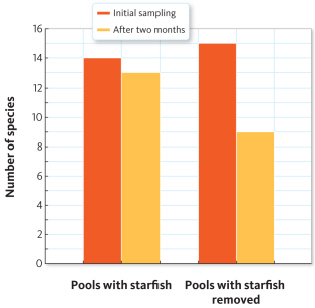Robert Paine was the first biologist to use the term keystone species in the 1960s. He was studying food webs in the rocky, intertidal pools in the Pacific Northwest. At one of his study sites, the dominant organisms in the tidal pools were mussels, barnacles, whelks, and a species of starfish known as Pisaster ochraceus . To examine the relationship between these species, Paine set up an experiment. In one area, he removed all the starfish from the tidal pools, and in an adjacent area, he left the tidal pools as he found them. Prior to removing the starfish, he sampled all the organisms in each pool. After two months, he repeated this sampling. A summary of his results is illustrated in the graph below.
In Paine's study, the starfish are the top predators in this system and eat each of the other species mentioned. Whelks eat both mussels and barnacles, while both mussels and barnacles are filter feeders that feed on small particles in the water, including algae and other autotrophs. In terms of the number of organisms, you would expect __________ to have the highest number of individuals.
A) mussels
B) whelks
C) starfish
D) both whelks and starfish
Correct Answer:
Verified
Q25: If you own a dog, each year,
Q26: Robert Paine was the first biologist to
Q27: A beetle that feeds on the leaves
Q28: Robert Paine was the first biologist to
Q29: The Saguaro cactus is a large cactus
Q31: Robert Paine was the first biologist to
Q32: Spiders are predators that will eat just
Q33: A beetle that feeds on the leaves
Q34: A beetle that feeds on the leaves
Q35: Some species of bean bug, which are
Unlock this Answer For Free Now!
View this answer and more for free by performing one of the following actions

Scan the QR code to install the App and get 2 free unlocks

Unlock quizzes for free by uploading documents